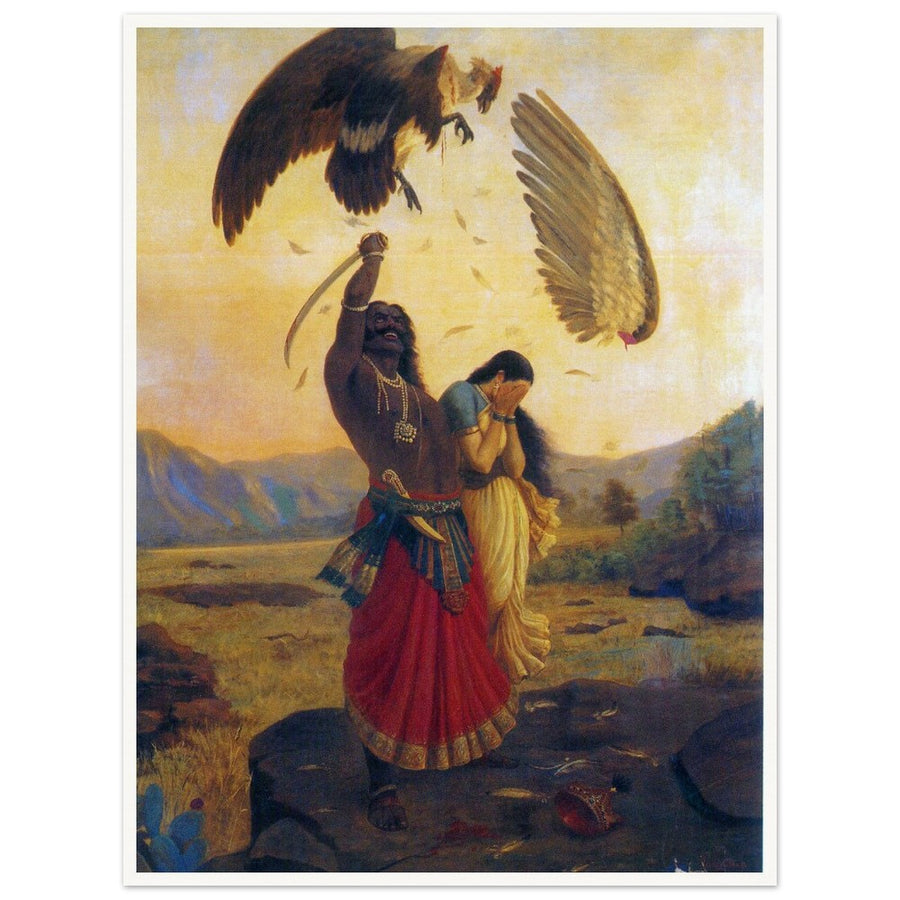Celebrating the Histories of Diwali
Every winter, photos of beautiful Diwali celebrations across the world flood our social media pages. This enchanting festival is celebrated widely across India and other parts of the world, and is sometimes also known as the 'Festival of Lights'. It is most widely known for being celebrated by Hindus, however also finds celebrants amongst Jain, Sikh, and Buddhist communities worldwide.

Raja Ravi Varma, Lakshmi Saraswati Sanyog
Depicting the Hindu deity Lakshmi, the consort of Vishnu, worshipped for her blessings of fortune and success.
Click here for our whole Asian artwork selection.
Early Origins of Diwali
It is thought that this beautiful celebration finds its origins as many as 2,500 years ago, due to descriptions found in ancient texts such as the Skanda Purana and Padma Purana of harvest festivals involving the lighting of lamps. As such, it is generally assumed that Diwali originated as an agrarian festival celebrating the end of harvest season, in which lamps would be lit and prayers would be said for prosperity and protection for their crops. It is both interesting and beautiful that Diwali and Halloween, two very different festivals, ultimately have their origins in a similar practise, of celebrating the end of harvest, creating lights, and saying prayers. Similarly to Western Halloween celebrations, Diwali has slowly been absorbed an incorporated into various regional traditions, becoming a major festival which blends religious stories, cultural practises, and community celebrations.
In Hindu Belief
There are many popular Hindu stories which are associated with Diwali, however the most popular is the ancient Indian epic, the Ramayana. In this legend, Lord Rama returns to his kingdom after 14 years of exile, during which he defeats the demon king Ravana. In the story, his return is celebrated by the people of Ayodhya by lighting Diyas to illuminate the city, marking the triumph of good over evil and light over darkness.
Another significant aspect of Diwali is the worship of Goddess Lakshmi, the deity of wealth, prosperity and fertility. It is believed by some celebrants that on the night of Diwali, Lakshmi roams the earth and blesses those who keep their homes clean and well-lit. As such, homes and businesses are adorned with lights, candles, and rangoli.
In some parts of India, Diwali is also associated with Lord Krishna’s victory over the demon Narakasura and his lifting of Govardhan Hill to protect villagers from a destructive storm sent by Lord Indra. These legends of divine triumph are celebrated in different parts of India, each adding its unique touch to the festival.

Raja Ravi Varma, Jatayu Vadha, 1906. Depicting a scene from the Ramayana, 'The Killing of Jatayu'
Diwali in Jain, Sikh, and Buddhist Traditions
While Diwali is widely known as a Hindu festival, it holds significant meaning for Jain, Sikh, and Buddhist communities as well.
-
Jain Tradition: In Jainism, Diwali marks the nirvana (spiritual enlightenment) of Lord Mahavira, the 24th and final Tirthankara (spiritual teacher). Lord Mahavira attained moksha (liberation) on Diwali in 527 BCE, making this day especially sacred for Jains, who light lamps to symbolize the dispelling of spiritual darkness and ignorance.
-
Sikh Tradition: Sikhs celebrate Diwali in connection with the release of Guru Hargobind Ji, the sixth Sikh Guru, from imprisonment in 1619. His freedom, along with the release of 52 other princes, was celebrated by lighting lamps upon his return to Amritsar. This day is observed as Bandi Chhor Divas, or the “Day of Liberation.”
-
Buddhist Tradition: In some Buddhist communities, especially in Nepal’s Newar tradition, Diwali is celebrated as part of the broader festival of Tihar. Though not directly related to the life of Buddha, Tihar incorporates rituals of light and prosperity, making it a culturally significant event for many Buddhists.

Gian Singh Naqqash, Guru Ram Das and the story of Dukh Bhanjani.
A beautiful example of Sikh art from our Asian Collection
Modern Celebrations
Today, Diwali combines ancient customs with modern festivities. Key elements of the celebration include:
- Lighting Diyas and Lamps: The lighting of diyas and other lamps continues to be a cherished tradition, symbolizing light’s victory over darkness;
- Fireworks: Firecrackers add sparkle and sound to the night, with explosions meant to ward off evil spirits. Recently, many have turned to eco-friendly fireworks to minimize environmental impact;
- Rangoli: Homes are decorated with intricate rangoli designs made with coloured powders, rice, or flowers, inviting prosperity and adding vibrant beauty to the occasion;
- Gifts and Sweets: Diwali is a time for sharing treats and gifts with friends and family, ranging from traditional sweets to thoughtful, personalized tokens.
As communities around the world embrace Diwali, it has become an opportunity for cultural sharing and global unity. Many cities hold public Diwali events, featuring parades, cultural performances, and lighting ceremonies that draw people from diverse backgrounds to celebrate the festival’s universal message of hope and togetherness.
In essence, Diwali’s beauty lies in its resilience and adaptability. This celebration of light, triumph, and renewal has captivated hearts for centuries and will continue to inspire for generations to come.
